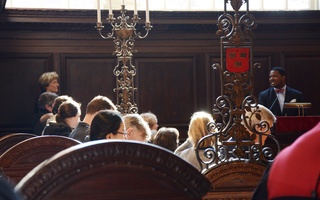It is not every biblical book that opens with God commanding his prophet to go marry a prostitute. But this is exactly what the prophet Hosea is told to do at the outset of his biblical career. “The Lord said to Hosea: ‘Go get yourself a wife of whoredom and children of whoredom; for the land will stray from the following of the Lord.’” Few readers of this story have ever taken it literally, especially given that in the ensuing fourteen chapters of the book, Hosea’s problematic marriage is used as an allegory for the relationship between God and the sinful Children of Israel. But consider, for a moment, if “Hosea” is not merely a metaphorical morality play, but rather did happen to a historical person, and a prophet of God no less. This prospect is essentially the premise of “The Prophet’s Wife.”
Attempting to flesh out the life of this peculiar prophet in a work of imaginative historical fiction is Milton Steinberg, formerly the rabbi of the Park Avenue Synagogue in New York City and a prolific author on Jewish thought. Much like its subject matter, the book is unusual. Though it was released to much fanfare this March, Steinberg died in 1950. “The Prophet’s Wife” is an unfinished manuscript, long preserved in boxes of papers and correspondence, and only now edited and presented to the public. The book has no ending, though not for lack of trying by numerous Jewish novelists—including Steinberg’s close friend, Herman Wouk—who were asked to provide one and failed. But at over 300 pages, “The Prophet’s Wife” doesn’t lack for thought-provoking content.
The title is something of a misnomer in that it doesn’t reflect which character the book actually follows. Though Steinberg gives his due to Gomer, the wayward wife of Hosea, the book takes place within the mind of Hosea himself. “The Prophet’s Wife” thus follows the prophet from a contemplative childhood, through his apprenticeship as a scribe, and into his troubled marriage and adulthood. Ironically, and most unfortunately, due to the book’s arrested development, the story never does get to Hosea’s actual prophetic career, aside from a brief glimpse afforded in the prologue.
In breathing literary life into Hosea, Steinberg asks several basic questions: What makes a person into a prophet? What character traits would one possess, and what sort of life would lead to such a calling? In Hosea’s case, the Bible is silent on his personal formation, allowing Steinberg a canvas upon which to freely project his own answers.
Like Steinberg’s only other work of fiction, “As a Driven Leaf”—in which he constructs a life for Elisha ben Abuyah, the Talmud’s own sage and heretic, out of short Talmudic stories about him and some healthy creative license—“The Prophet’s Wife” uses an intriguing traditional character as the starting point for a meditation on the religious experience. For the protagonist of “As a Driven Leaf,” the conundrum is whether faith is possible in a rational world. For Hosea in “The Prophet’s Wife,” the question is how to live that life of faith, once one has chosen it. In both books, Steinberg adeptly uses tradition to pose contemporary questions.
Perhaps unsurprisingly, this very modern novel has a fraught relationship with its ancient source material. On the one hand, the text of the story is rife with biblical allusions. Some are direct citations made by characters, some inform the book’s conversations in paraphrase, and still others are simply biblical phrases woven directly into the fabric of Steinberg’s narrative. The somewhat stilted wording of the Bible in English translation assimilates easily into Steinberg’s high register prose style, and in this manner, the milieu of the story pervades the storytelling.
Yet God does not speak in this retelling of the Bible. Hosea’s words and actions stem from his own personal inclinations. In the Bible, God orders him to marry Gomer; in Steinberg’s book, the marriage comes about naturally. Likewise, Steinberg’s Hosea preaches from experience, not divine ecstasy. This is the story as a modern writer—uncomfortable with the idea of a too personal God and drawn to a materialistic understanding of human affairs—would tell it. Thus, even as Steinberg draws upon the Bible for his inspiration, he distances himself from it. Through this lens, “The Prophet’s Wife” is one theologian’s attempt at rational rapprochement with the Bible, and in this case, the idea of inspired prophecy. It is a move from the original prophetic intonation of “thus spake the Lord” to “thus spake my heart.” There is a distinct tension between the old and the new.
It is rare today that a novel grapples with the several thousand years of Jewish history and heritage that preceded America, rather than only addressing the issues surrounding modern Jewish life. Mainstream Jewish authors such as Philip Roth or Jonathan Safran Foer are writing about Jews, but not so much about Judaism. Less common is the Chaim Potok or the Milton Steinberg who attempts to bring the vast Jewish past into dialogue with the Jewish present.
The singularity of Steinberg’s mode of writing helps explain the curious sight of many Jewish public and literary luminaries—Elie Wiesel, Cynthia Ozick and Harold Kushner among them—all suddenly seizing the coattails of this rather obscure rabbi now six decades deceased, and adorning “The Prophet’s Wife” with glowing blurbs, introductions and even back-of-the-book commentaries. If there is a lesson beyond the theological to be derived from “The Prophet’s Wife,” it is that this is a genre worth reviving. Steinberg never finished his book, but its publication reopens the door for others to write their own entries in his renewed tradition.
—Staff writer Yair Rosenberg can be reached at yrosenb@fas.harvard.edu.
Read more in Arts
Remember Me













